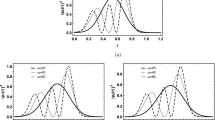Abstract
We study a microscopic Hamiltonian model describing an N-level quantum system \({\mathcal{S}}\) coupled to an infinitely extended thermal reservoir \({\mathcal{R}}\). Initially, the system \({\mathcal{S}}\) is in an arbitrary state while the reservoir is in thermal equilibrium at inverse temperature \({\beta}\). Assuming that the coupled system \({\mathcal{S}+\mathcal{R}}\) is mixing with respect to the joint thermal equilibrium state, we study the Full Counting Statistics (FCS) of the energy transfers \({\mathcal{S} \to \mathcal{R}}\) and \({\mathcal{R} \to \mathcal{S}}\) in the process of return to equilibrium. The first FCS describes the increase of the energy of the system \({\mathcal{S}}\). It is an atomic probability measure, denoted \({\mathbb{P}_{\mathcal{S},\lambda,t}}\), concentrated on the set of energy differences \({{\rm sp}(H_{\mathcal{S}})-{\rm sp}(H_{\mathcal{S}})}\) (\({H_{\mathcal{S}}}\) is the Hamiltonian of \({\mathcal{S}}\), t is the length of the time interval during which the measurement of the energy transfer is performed, and \({\lambda}\) is the strength of the interaction between \({\mathcal{S}}\) and \({\mathcal{R}}\)). The second FCS, \({\mathbb{P}_{\mathcal{R},\lambda,t}}\), describes the decrease of the energy of the reservoir \({\mathcal{R}}\) and is typically a continuous probability measure whose support is the whole real line. We study the large time limit \({t \rightarrow \infty}\) of these two measures followed by the weak coupling limit \({\lambda \rightarrow 0}\) and prove that the limiting measures coincide. This result strengthens the first law of thermodynamics for open quantum systems. The proofs are based on modular theory of operator algebras and on a representation of \({\mathbb{P}_{\mathcal{R},\lambda,t}}\) by quantum transfer operators.
Similar content being viewed by others
References
Aizenstadt V.V., Malyshev V.A.: Spin interaction with an ideal Fermi gas. J. Stat. Phys. 48, 51–68 (1987)
Aschbacher, W., Jakšić, V., Pautrat, Y., Pillet, C.-A.: Topics in non-equilibrium quantum statistical mechanics. In: Attal, S., Joye, A., Pillet, C.-A. (eds.) Open Quantum Systems III. Recent Developments. Lecture Notes in Mathematics, vol. 1882. Springer, Berlin (2006)
Aschbacher, W., Jakšić, V., Pautrat Y., Pillet C.-A.: Transport properties of quasi-free Fermions. J. Math. Phys. 48, 032101-1-28 (2007)
Bilingsley, P.: Convergence of Probability Measures. Willey, New York (1968)
Bach V., Fröhlich J., Sigal I.M.: Return to equilibrium. J. Math. Phys. 41, 3985–4060 (2000)
Benoits, T., Jakšić, V., Panati, A., Pautrat, Y., Pillet, C.-A: Energy Conservation and Full Counting Statistics. arXiv:1503.07333(submitted)
Benoits, T., Jakšić, V., Panati, A., Pautrat, Y., Pillet, C.-A: In preparation
Bratteli, O., Robinson, D.W.: Operator Algebras and Quantum Statistical Mechanics I 2nd edn. Springer, Berlin (1987)
Bratteli, O., Robinson, D.W.: Operator Algebras and Quantum Statistical Mechanics II 2nd edn. Springer, Berlin (1997)
Botvich D.D., Malyshev V.A.: Unitary equivalence of temperature dynamics for ideal and locally perturbed Fermi-gas. Commun. Math. Phys 91, 301–312 (1983)
Callen, H.B.: Thermodynamics and an Introduction to Thermo-Statistics. Wiley, New York (1985)
de Roeck W., Kupianien A.: ‘Return to equilibrium’ for weakly coupled quantum systems: a simple polymer expansion. Commun. Math. Phys. 305, 1–30 (2011)
Dereziński J., Jakšić V.: Return to equilibrium for Pauli–Fierz systems. Ann. Henri Poincaré 4, 739–793 (2003)
Dereziński J., Jakšić V., Pillet C.-A.: Perturbation theory of W *-dynamics, Liouvilleans and KMS-states. Rev. Math. Phys. 15, 447–489 (2003)
Fröhlich J., Merkli M.: Another return of “return to equilibrium”. Commun. Math. Phys. 251, 235–262 (2004)
Fröhlich J., Merkli M., Ueltschi D.: Dissipative transport: thermal contacts and tunneling junctions. Ann. Henri Poincaré 4, 897–945 (2003)
Fröhlich, J., Merkli, M., Schwarz, S., Ueltschi, D.: Statistical mechanics of thermodynamic processes. In: Arafune, J., Arai, A., Kobayashi, M., Nakamura, K., Nakamura, T., Ojima, I., Sakai, N., Tonomura, A., Watanabe, K. (eds.) A Garden of Quanta. Essays in Honor of Hiroshi Ezawa. World Scientific Publishing, Singapore (2003)
Jakšić, V., Ogata, Y., Pautrat, Y., Pillet, C.-A.: Entropic fluctuations in quantum statistical mechanics—an introduction. In: Fröhlich, J., Salmhofer, M., Mastropietro, V., De Roeck, W., Cugliandolo, L.F. (eds.) Quantum Theory from Small to Large Scales. Oxford University Press, Oxford (2012)
Jakšić V., Ogata Y., Pillet C.-A.: The Green–Kubo formula and the Onsager reciprocity relations in quantum statistical mechanics. Commun. Math. Phys. 265, 721–738 (2006)
Jakšić V., Ogata Y., Pillet C.-A.: The Green–Kubo formula for locally interacting fermionic open systems. Ann. Henri Poincaré 8, 1013–1036 (2007)
Jakšić V., Pillet C.-A.: On a model for quantum friction III. Ergodic properties of the spin-boson system. Commun. Math. Phys. 178, 627–651 (1996)
Jakšić V., Pillet C.-A.: Spectral theory of thermal relaxation. J. Math. Phys. 38, 1757–1780 (1997)
Jakšić V., Pillet C.-A.: On entropy production in quantum statistical mechanics. Commun. Math. Phys. 217, 285–293 (2001)
Jakšić V., Pillet C.-A.: Mathematical theory of non-equilibrium quantum statistical mechanics. J. Stat. Phys. 108, 787–829 (2002)
Jakšić V., Pillet C.-A.: Non-equilibrium steady states of finite quantum systems coupled to thermal reservoirs. Commun. Math. Phys. 226, 131–162 (2002)
Jakšić V., Pillet C.-A.: A note on the entropy production formula. Contemp. Math. 327, 175–180 (2003)
Levitov L.S., Lesovik G.B.: Charge distribution in quantum shot noise. JETP Lett. 58, 230–235 (1993)
Panangaden, J.: Master’s thesis, McGill University (in preparation)
Pillet, C.-A.: Quantum dynamical systems. In: Attal,S., Joye, A., Pillet, C.-A. (eds.) Open Quantum Systems I. The Hamiltonian Approach. Lecture Notes in Mathematics, vol. 1880. Springer, Berlin (2006)
Robinson D.W.: Return to equilibrium. Commun. Math. Phys. 31, 171–189 (1973)
Thirring, W.: Quantum Mathematical Physics: Atoms, Molecules and Large Systems 2nd edn. Springer, Berlin (2002)
Author information
Authors and Affiliations
Corresponding author
Rights and permissions
About this article
Cite this article
Jakšić, V., Panangaden, J., Panati, A. et al. Energy Conservation, Counting Statistics, and Return to Equilibrium. Lett Math Phys 105, 917–938 (2015). https://doi.org/10.1007/s11005-015-0769-7
Received:
Accepted:
Published:
Issue Date:
DOI: https://doi.org/10.1007/s11005-015-0769-7



